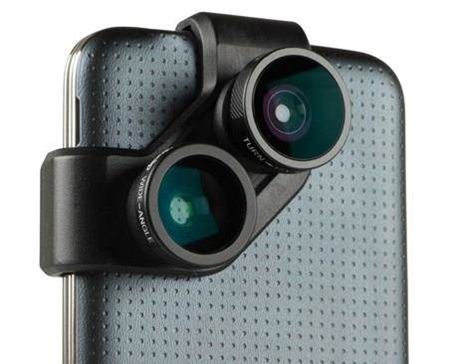To be honest, I think that ‘smartphone’ photography is reaching down into the bottom of the barrel. Creativity, which is why I take photographs, has not really been possible with the so-called ‘smartphones’. As a record shot showing a photo of someone somewhere they are probably excellent. However, seeing media photographers pointing their phones at a car during its press release makes me cringe. The prime function of these phones is still to allow you to speak to people in far away places. Full stop!
There is, however, a group of far-seeing technicians who are realizing the drawbacks and limitations of the smartphone, and are producing “add-ons” to improve on what in reality is a fairly primitive photo device.

Here are some of these. Photojojo are selling clip-on lenses for the iPhone 6 and Galaxy S5. These are supposed to give your phone the choices of wide angle and macro capabilities. Undoubtedly, if you have either of those this expands the range of shots possible. The final result may be a compromise I imagine.
Tripods are certainly a great adjunct to good photography, and one that I promote for time-lapse, long exposures and landscapes, a tripod is a must-have. There is now one for your phone called the Glif which apparently will fit in your pocket as well as anchoring your phone. There is another called the GorillaPod GripTight, which will let your phone cling to trees, doorknobs and handlebars.
Remote shutters have been part of the DSLR scenes for ever, but now this is being touted for phones as well, with the article mentioning this saying that it is “a wonder for taking selfies that don’t show your arm reaching toward the camera. It hooks up with your iPhone or Android phone wirelessly and takes a picture when you hit the button.” OMG, it’s the “selfie” again!
The smart geeks have admitted that the flash on the phone is pretty worthless when it comes to lighting up dark scenes. “The iBlazr plugs into your headphone port and massively increases your flash power. If anything, it may be too bright – but that’s better than the alternative.” Welcome to the world of blown-out pictures.
One area of common ground is the battery which can always fail just when you are about to take that award-winning shot. Smart people will use the cheap and portable Anker battery. Better yet, they will buy a few and keep them where you know you’ll need them: in the car, in your purse, with your emergency supplies.
So those gadgets may improve your smartphone pictures, but here is a DSLR feature that the geeks haven’t managed to copy. Getting good photos it is often necessary to “bracket”. Most DSLR’s have this function. With mine I have set it up to give me three automatically bracketed shots, each half a stop different. One below the presumed correct setting and one above. This gives me three shots to review, and 99 times out of 100, one of those three will be the best exposure.
Another ‘pro’ tip is in the placement of the subject in the frame. We know that the most pleasant visual effect is when the subject is not bang in the middle, but off center. Simply make sure the subject is one third in from either edge of the viewfinder. This is the “Rule of Thirds.” Don’t have the horizon slap bang in the center of the picture either. As a rough rule of thumb, if the sky is interesting put more of it in the picture, but if it is featureless blue or grey include less of it!
Now, many digital cameras have an optional grid you can have in the viewfinder, with just a push of a button and a selection from the digital menu. This grid automatically shows you whether your horizon is level and where it is in the photo – one third down from the top, or one third up from the bottom. The grid also shows you exactly where to place your subject – at the intersection of thirds. In my early digital days I would have to hand draw the grid on the focusing screen. Now the digital camera does it for me. My phone doesn’t.




